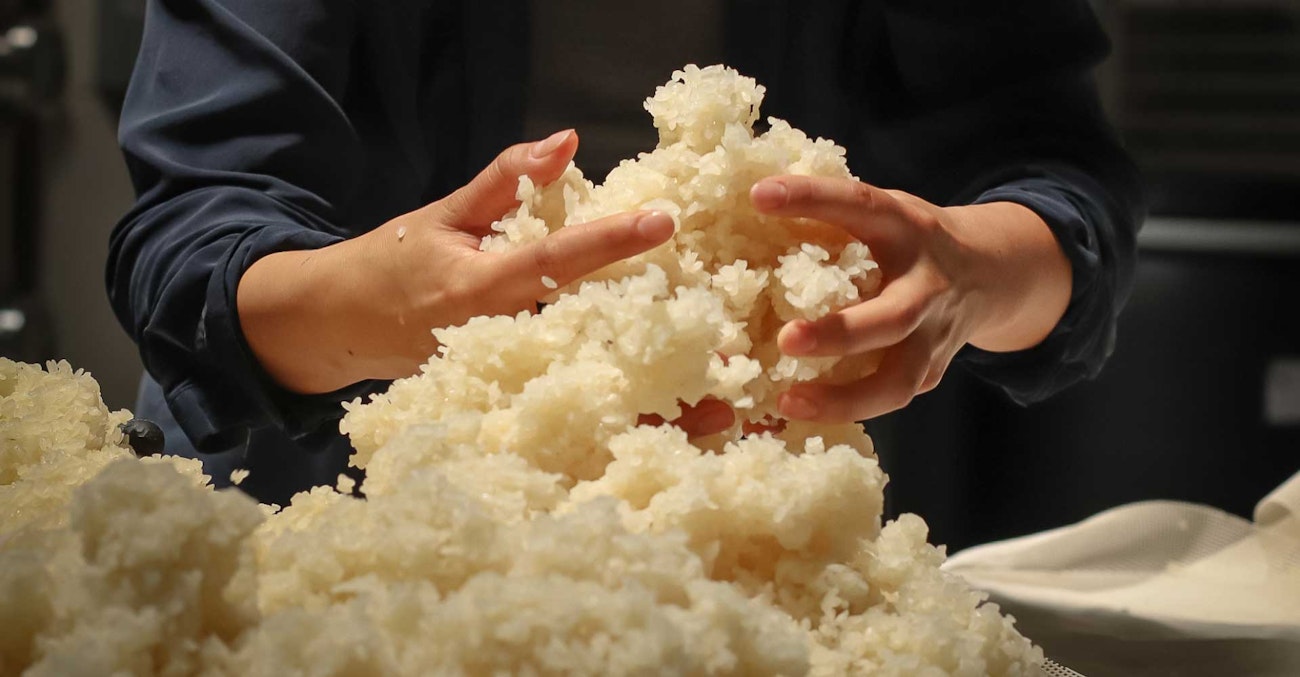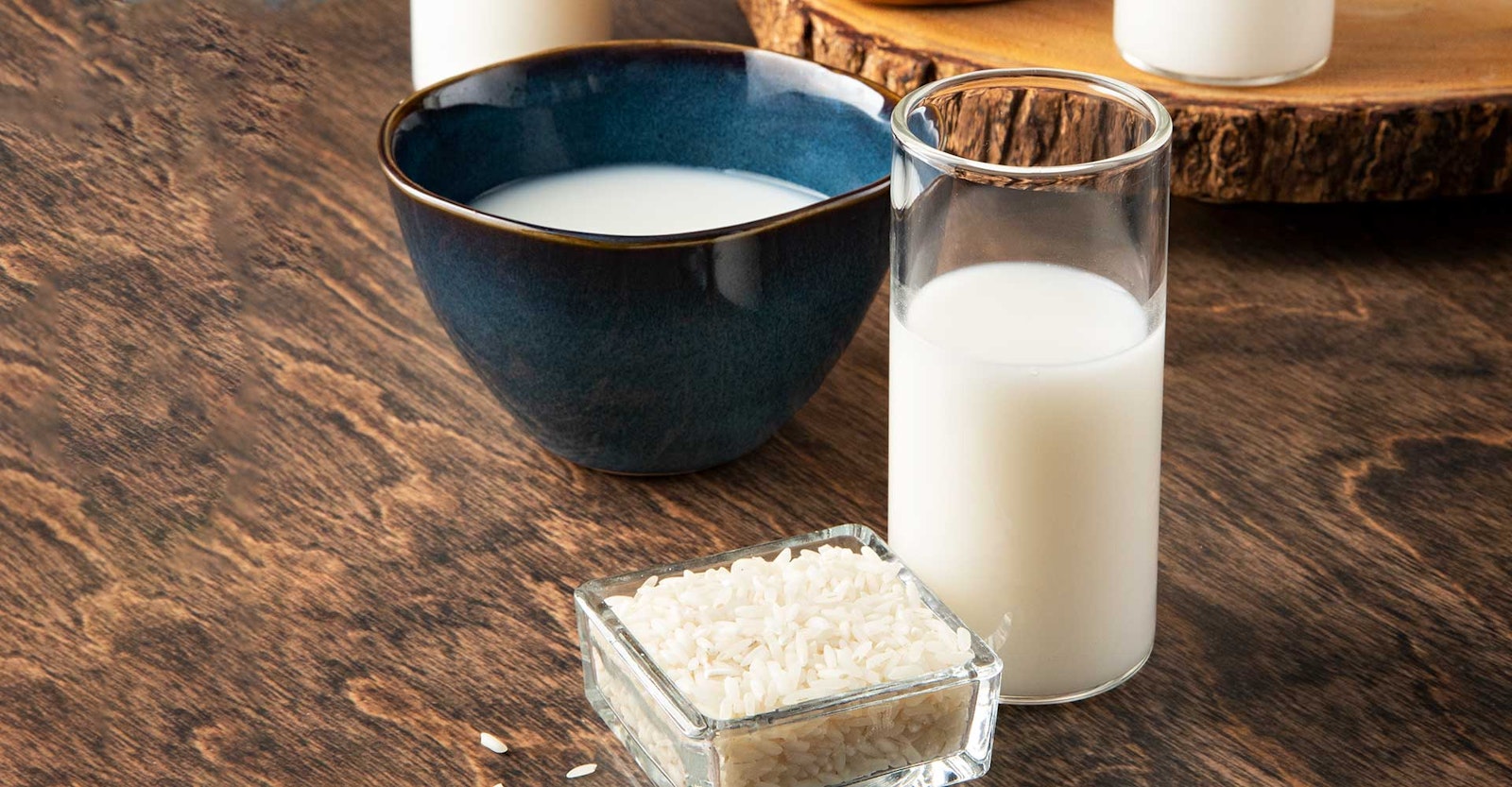There’s a new fermented drink in town—new to many American drinkers, anyway. In fact, makgeolli is ancient; as a rice drink, it is thought to be Korea’s oldest alcoholic beverage. Now, thanks in large part to two New York City–based producers, it’s sparking more interest on the American craft-beverage scene.
So, what is it?
For Alice Jun, founder of Hana Makgeolli in Brooklyn, defining makgeolli starts with defining sool. That’s the word that Koreans use today for all kinds of alcoholic drinks—it means booze, essentially—but its older meaning is especially connected to traditions of fermented drinks. Specifically, Jun defines it as a traditional grain-based beverage fermented with nuruk.
Nuruk is a fermentation starter—typically a rice-, wheat-, and/or barley-based inoculate that includes wild fungi and bacteria, including yeast and Lactobacillus. Sool, meanwhile, isn’t necessarily rice-based—it can be made from anything from wheat or sorghum to sweet potato or tapioca. Makgeolli, however, is a type of sool made with rice. It is roughly filtered and typically strong, clocking in between 6 and 18 percent ABV.
Sool also happens to be the name of the other company producing craft makgeolli in the United States. Its Màkku brand is called “rice beer” to abide by certain TTB regulations. However, founder Carol Pak says this can be difficult to explain, since it could be confused with rice lager. As with Japanese sake, many people refer to makgeolli as “rice wine,” even if it is technically beer.
Visually, however, there is no mistaking makgeolli for rice lager. The drink is milky-looking, thanks to the sediment that remains after some coarse filtering. It’s carbonated, but on the lower end of the scale, comparable to a lively cask ale. (Sool force-carbonates Màkku, while Hana carbonates naturally during fermentation.)
The flavors can be wide-ranging and complex. Depending on the rice, the nuruk, fermentation time and temperature, and possible botanical additions, makgeolli can be any combination of sweet, tart, funky, sour, bitter, floral, and earthy—a fascinating universe of possibility for a niche traditional drink.
Makgeolli Comes to America
Hana Makgeolli has an airy space away from the well-trodden blocks of Brooklyn’s Greenpoint neighborhood, but curious local drinkers are increasingly seeking it out. Jun is a second-generation Korean American, and she grew up homebrewing makgeolli with her father in rural California.
“Homebrewing was an extremely common domestic practice across Korea, just before the 1950s,” Jun says. “Families pass that information through generations. My dad learned from his mother, and I learned from my dad when I was quite young. It’s something we did at home, casually, in the same way that we cook together.”
When brewing a heritage-based style without recipes at the ready, as Jun says, mistakes happen. Intrigued, she began researching those mistakes, trying to figure out why they happen. Along the way, other elements of makgeolli sparked a passion. Jun learned about how women developed, advanced, and documented makgeolli. She learned about its importance in times of war, occupation, famine, and industrialization in Korea. She sought out Korean expertise on makgeolli brewing, with the idea of bringing an artisanal version to the United States.
When talking about launching their companies, both Jun and Pak cite their own love of the taste of makgeolli and the experiences of sharing it with friends and pairing it with food. They also speak of their desire to offer people of Korean heritage something familiar, as well as to reach people who’ve never tried it before.
As it happens, industry trends may have helped make their timing auspicious. Before the hard-seltzer boom, Pak worked for a hard kombucha brand, where she watched the trajectory of drinks such as hard kombuchas, teas, and ciders, often between 4 and 7 percent ABV, with no hops, plenty of flavor variation, and typically some sweetness.
“Makgeolli … has a lot of similar characteristics,” Pak says, “but it’s still widely different from everything in terms of its flavor profile.”
The commercial availability of makgeolli isn’t new. Possibly found in a Korean restaurant or Asian grocery, the makgeolli often spotted stateside comes in green bottles—as does its cousin, soju, which is also made from rice, water, and nuruk, but is drier and higher in alcohol. There is a whole system of bottling companies sharing and recycling these bottles, and companies simply source ready-made ingredients—including ethanol and sweeteners—bottle it up, and ship it off. They are not the kind of artisanal products that Hana and Sool make.
“I don’t think there’s necessarily anything wrong with it,” Jun says of the mass-produced, green-bottled makgeolli. “There definitely is a time and place for it in social settings with different meals. … That being said, I do have a problem with people saying that is definitively what makgeolli should be without any real historical context or openness to learning how that product was made in the first place.”
Jun says that these commercial makgeolli are often made with highly processed wheat flour or tapioca flour, rice flavoring, citric acid, and sweetening agents such as aspartame—an arguably outdated choice, she says, considering what we know about aspartame today and how many other alternatives exist.

Photo: Courtesy Hana
Makgeolli’s Resurgence in Korea
The way commercial makgeolli has come to be made—as well as its more recent craft revival in Korea—are just part of makgeolli’s long history.
The first documented mention of makgeolli dates to the 10th century. It was considered a drink of the working classes—it was cheap and easy to make, and farmers could use excess rice crops. Fast-forward to the 20th century, when the Japanese occupation of Korea (1910–1945) and then the Korean War (1950–1953) introduced various obstacles to the tradition, whether related to supply or politics or culture. In 1934, the Japanese imperialist government banned homebrewing, so that all alcohol would be produced in factories and taxed. In 1965, the South Korean government banned the use of rice to make alcohol because of rice shortages and hunger. It did not lift the rice-drink ban until 1990, and the homebrewing ban lasted still another decade.
During these bans, Pak says, people started making makgeolli with different grains and rice flavorings. As larger makgeolli producers did the same, the heritage style of makgeolli brewing was temporarily lost. New generations got to know makgeolli as a sweet, soda-like beverage, stereotyped as an “old person’s drink”—or, as Jun says, marketed as a “drink for women.” However, more recently, a younger generation of Korean and Korean-American adults are seeking out traditional makgeolli as a connection to their cultural roots.
“Before, makgeolli had a stigma [that] it was for old people, and Korea was growing, becoming rich, and the generation before ours didn’t want anything to do with a cheap drink,’” Pak says. “They wanted to westernize—drink wine, spirits, and new products.” Many in Pak’s generation, however, want to celebrate Korean heritage, and makgeolli is an integral part of that.
A proliferation of craft-makgeolli breweries and bars in Korea helped inspire Pak to launch the Màkku brand in the United States. Every year she returns to Korea, she finds there are dozens more breweries and bars; she compares it to the American craft-beer scene. Not only are younger people exploring their culture through makgeolli, but there’s also what Pak describes as a relatively low barrier of entry in how straightforward it is to make makgeolli. That encourages more people to start brewing.
Nuruk, the Main Attraction
Nuruk is the workhorse of a makgeolli recipe. Amahl Turczyn, an associate editor for the Brewers Association who’s written about makgeolli for Zymurgy magazine, compares nuruk to koji for fermenting sake, or to SCOBY for fermenting kombucha.
The first step is preparing the rice. Jun says that unpolished rice is the choice of traditional makgeolli brewers, but glutinous or normal medium-grain rice can also be used. It must be washed and soaked, then cooked so it’s gelatinized and ready for saccharification. After adding water and nuruk, fermentation kicks off almost immediately.
Makgeolli is coarsely filtered; some sediment will remain. Sool urges customers to shake its Màkku cans before opening, so the rice sediment creates the hazy, smooth creaminess characteristic of makgeolli.
Pak compares the result to a sake seltzer. Makgeolli, she says, “has a mochi-like texture. It’s soft, and it tastes like sake because of the rice, but there are also floral and fruity notes from the yeast, and a slight tartness from the Lactobacillus by-product of nuruk.”
As far as branching out from there to be funkier or sweeter or drier or more bitter, it’s about process and methodology, Jun says. “What can you do about the type of rice you use, how you cook it? When do you introduce it to a brew? What temperature is it kept at?”
The initial fermentation takes about four to six days. Continuing to feed rice into the brew deepens the flavor, Pak says. Every further rice addition means another round of fermentation. It lengthens the process but makes for a naturally sweeter finished product. For Màkku, Pak does two different stages, taking about 10 days.
There’s an element of terroir, too, and the fermentation starter is vital to that. “The terroir is driven by the nuruk,” Jun says. “Of course, the rice and where it’s grown, too, but mostly the nuruk.” Nuruk made in northern parts of Korea tends to be drier and more bitter; nuruk from Korea’s southernmost region leans more lactic, tarter, and sweeter.
Brewers can add other flavors, too. Hana adds chrysanthemum flowers and hydrangea tea leaves to its Hwaju 12, which is fermented in four stages. Sool adds fruit purees to finished makgeolli to create passion fruit, blueberry, and mango varieties.
Beginning to Brew Makgeolli
Mirandi Pohl is production manager at Hana, after having most recently brewed at Queens Brewery. Diving in to learn every aspect of makgeolli brewing has not only been rewarding, she says, but it also has crystallized the similarities and differences between brewing beer and makgeolli.
Cleaning is a huge element of both processes. The equipment mostly straddles both worlds: Some of the makgeolli kit is specific, but tanks have been repurposed from beer breweries with Jun’s engineering know-how. Pohl says there is a lot more physical contact with the ingredients than expected. Also, because of the lactic bacteria involved, makgeolli brewers aren’t as afraid of oxygen as beer brewers. “It’s actually important to the process,” she says, “which is the opposite of what I’ve known or been taught about fermentation.”
You don’t need to be in New York to try craft makgeolli. Hana ships to 41 states, and Sool ships Màkku to 28. Or, of course, you can brew it yourself.
Some basics to start, via Turczyn: After cleaning and cooking your rice, cool it to 70–75°F (21–24°C). Put it in a clean container, sprinkle your nuruk on top, and mix it for a consistency like wet sand. “It will be quite dry,” Turczyn says. “Once those enzymes break down, it liquefies.”
Keep the container at a warm temperature, covered with cloth. Stir twice a day, and you’ll see carbon dioxide production start. When the sediment starts to drop, the makgeolli turns a sort of amber, so you can sieve that sediment out.
Homebrewing makgeolli is a connection to the way this tradition has traveled through Korean families for generations. The simple act of drinking it is a celebration of culture. And, as Jun says, it “shines a light on the artisanal makgeolli brewers in Korea, who deserve to have their products respected.”

